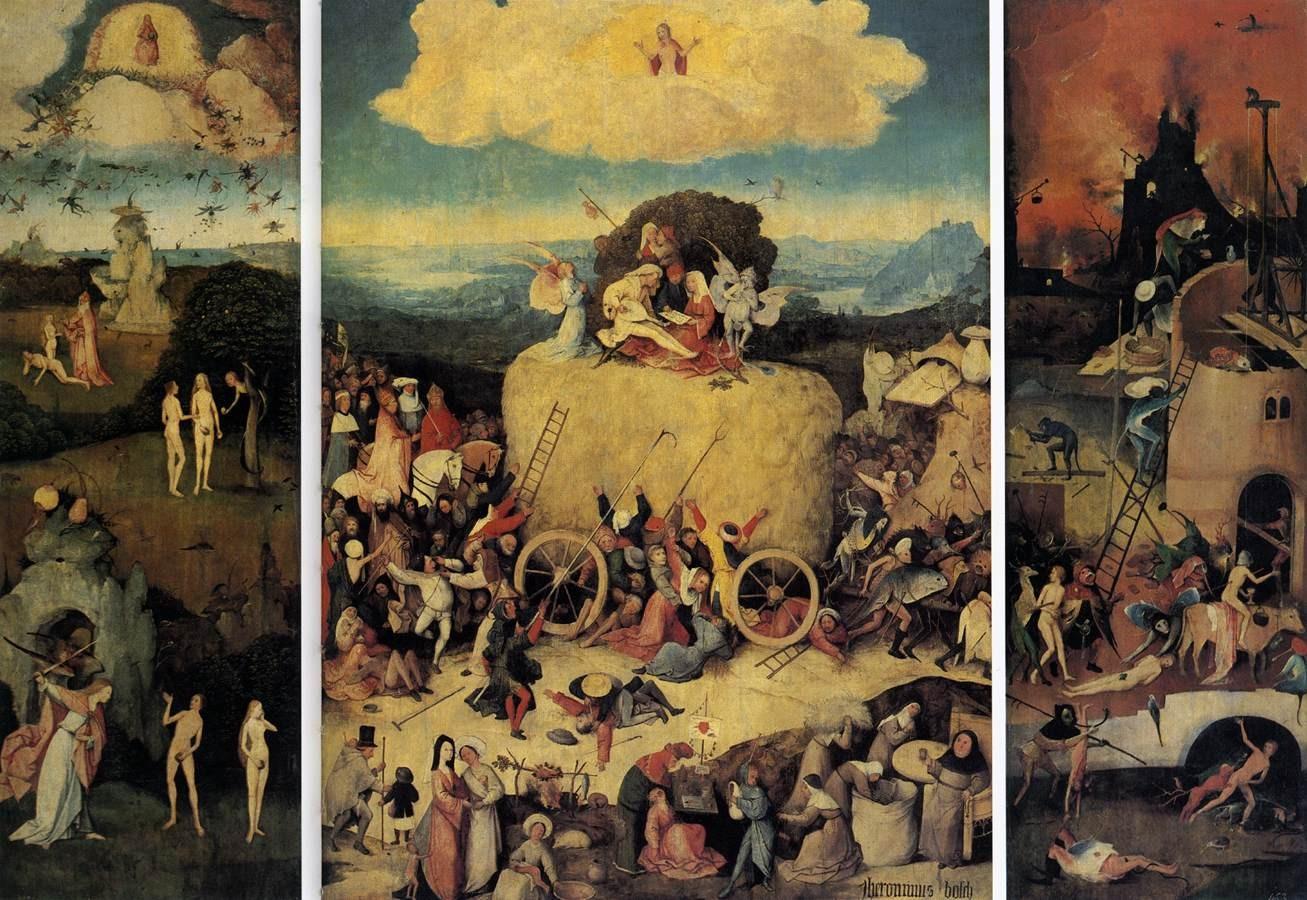Hieronymus Bosch was one of the most remarkable and original painters of all time. His works were painted five hundred years ago, yet they seem astonishingly modern, anticipating surrealism. This is the art of a world in a state of turbulence, torn by contradictory tendencies – a world in which the light of reason has been extinguished and where animal passions have gained the upper hand. A world of terror, violence and plague: a living nightmare. In short – a world very like our own, particularly given the current pandemic. Alan Woods examines Hieronymus Bosch from the standpoint of historical materialism. Originally published 23 December 2010.
Little is known of the life of the man we know as Hieronymus Bosch. Even the name is not his own, but the pseudonym with which he signed his work. His real name was Jeroen Anthoniszoon van Aken, and he was born about 1450 in the prosperous Dutch commercial town of ‘s-Hertogenbosch, near the German border. It was a prosperous town of about 25,000 residents. Linen-weaving was the most important industry. But it was also known for its organ builders, bell founders, printers, and forgers of knives, weapons, nails, and pins. About 90 percent of the population worked on the land.
Bosch lived through the period of what Huizinga has called the waning of the Middle Ages. It coincided with the beginning of that great cultural reawakening we call the Renaissance. Research and scientific discoveries flourished in an atmosphere of intellectual curiosity. Beneath the outward show of processions, pilgrimages, and piety, people were increasingly sceptical toward the Church and had doubts about the God-given order of things. The invention of the printing-press brought learning to a wider range of people.
This was a major turning-point in history. This was a period when the foundations of feudalism were being undermined by capitalism, as Marx and Engels explained:
“From the serfs of the Middle Ages sprang the chartered burghers of the earliest towns. From these burgesses the first elements of the bourgeoisie were developed.
“The discovery of America, the rounding of the Cape, opened up fresh ground for the rising bourgeoisie. The East-Indian and Chinese markets, the colonization of America, trade with the colonies, the increase in the means of exchange and in commodities generally, gave to commerce, to navigation, to industry, an impulse never before known, and thereby, to the revolutionary element in the tottering feudal society, a rapid development.
“The feudal system of industry, in which industrial production was monopolized by closed guilds, now no longer sufficed for the growing wants of the new markets. The manufacturing system took its place. The guild-masters were pushed on one side by the manufacturing middle class; division of labour between the different corporate guilds vanished in the face of division of labour in each single workshop.” (The Communist Manifesto, Bourgeois and Proletarians)
The prosperity of s’Hertogenbosch was derived from the introduction of capitalist methods. In the Middle Ages, all activities of the skilled trades were regulated by guilds. Now, however, employers introduced new production methods. Those who were successful made more profit than the traditional masters of various crafts and amassed great fortunes. The aristocratic rulers of the Netherlands allied themselves to the bourgeoisie and took their share of the profits from the new capitalist modes of production. But the guilds resisted changes that threatened them with ruin. The conflict between these conflicting interests at times came close to civil war.
Bosch was only rediscovered in the 20th century, having suffered oblivion for almost three centuries. This is no accident. Previous generations could not understand this strange art. This is the art of a world in a state of turbulence, torn by contradictory tendencies – a world in which the light of reason has been extinguished and where animal passions have gained the upper hand, a world of terror and violence, a living nightmare. In short – a world very like our own.
A period of transition
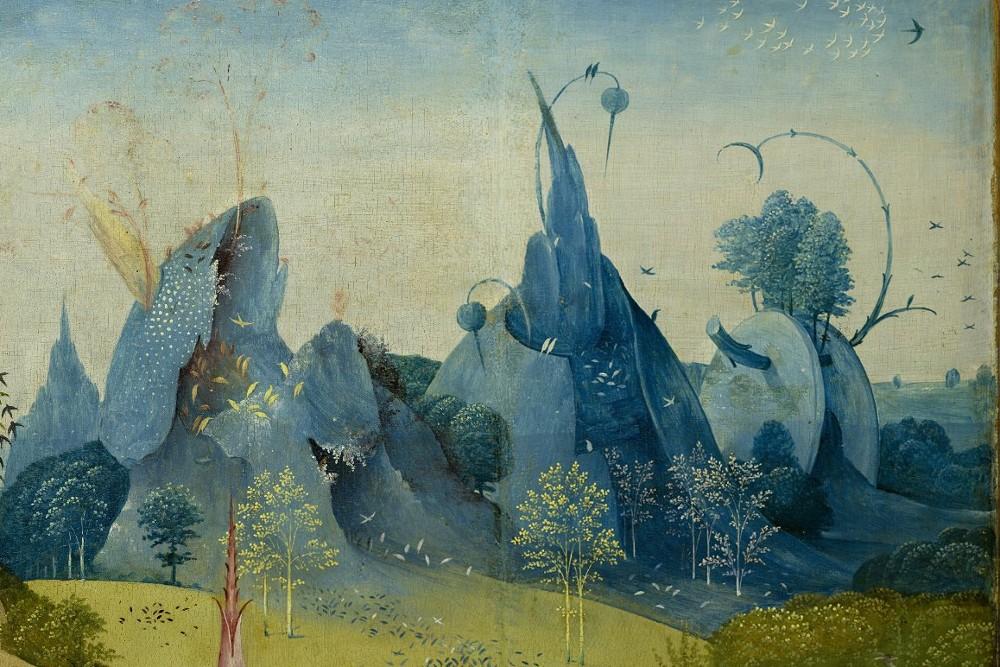 Detail of mountains from Bosch's "The Garden of Earthly Delights" Though separated from the modern world by over five hundred years, Bosch’s work seems to say more to us than a lot of more recent art. It is more relevant to the world we live in. This art has a strange and fascinating beauty, but what it does not appear to have is logic. Human reason is challenged at every step. Reality is stood on its head. We are confronted with images so unbelievable, so at variance with our normal view of the world that we come away feeling dizzy. Here Hegel’s expression hits us with full force: Reason becomes Unreason.
Detail of mountains from Bosch's "The Garden of Earthly Delights" Though separated from the modern world by over five hundred years, Bosch’s work seems to say more to us than a lot of more recent art. It is more relevant to the world we live in. This art has a strange and fascinating beauty, but what it does not appear to have is logic. Human reason is challenged at every step. Reality is stood on its head. We are confronted with images so unbelievable, so at variance with our normal view of the world that we come away feeling dizzy. Here Hegel’s expression hits us with full force: Reason becomes Unreason.
Strangeness is the very essence of this art. It is a reflection of a world that is no longer at one with itself, that is fractured at every point. The ground under our feet is no longer solid. What is solid turns to liquid and vice-versa. The very mountains in central part of The Garden of Earthly Delights seem to have become transformed into monstrous plants that are bursting open with an unnatural ripeness. Everything is changing into its opposite, or, to quote the celebrated words of Heraclitus: “Everything is and is not for everything is in flux.”
From a stylistic point of view, Bosch’ work does not seem to resemble either medieval art or the art of the Renaissance. Although elements of both these are present, Bosch’s art strikes us as amazingly modern. The images are so surprising, even shocking, the juxtapositions so contradictory and unexpected, that one would have to look to the world of surrealism to find anything remotely similar. In fact, the nightmarish quality of these images has a far greater impact than Dali’s tortured torsos and limp watches.
Despite its apparently anarchistic and irrational character, however, this art is really a faithful representation of the world in which Bosch lived. This is the art of a period of transition: the age of the decline of feudalism and the rise of capitalism. This was a time of tremendous upheavals and change. The feudal order was in a state of irreversible decline and the bourgeoisie in the towns was in the process of challenging the old order and demanding its rights.
When a given socio-economic system is going forward, there is a general feeling of confidence and optimism. Nobody question the existing order, its ideals and morality. But now the old world of the Middle Ages, with its firm foundations of religious faith, was crumbling. Suddenly everything was thrown into the melting pot. The system of religious beliefs that had held sway for the thousand years since the dissolution of the Roman Empire was in crisis. In its place a universal mood of scepticism and cynicism began to take hold of society. The general social upheaval found its reflection in universal doubt.
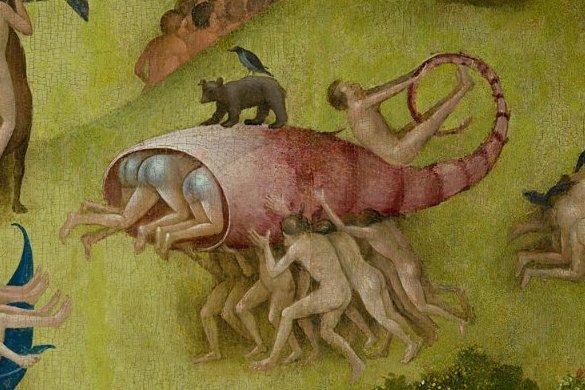 Detail of humans carrying fish from Bosch's "The Garden of Earthly Delights" This is a world gone mad, a world that is sick unto death and can find no remedy for its sickness. The all-pervading theme of the central panel of Bosch’s great triptych The Garden of Earthly Delights is precisely a kind of disgusting over-ripeness. Gigantic fish are a fairly obvious phallic symbol. Sin (often associated with sex) is conveyed by grotesquely huge and fleshy fruit, especially strawberries. Its very ripeness, suggesting inner decay, is what disgusts.
Detail of humans carrying fish from Bosch's "The Garden of Earthly Delights" This is a world gone mad, a world that is sick unto death and can find no remedy for its sickness. The all-pervading theme of the central panel of Bosch’s great triptych The Garden of Earthly Delights is precisely a kind of disgusting over-ripeness. Gigantic fish are a fairly obvious phallic symbol. Sin (often associated with sex) is conveyed by grotesquely huge and fleshy fruit, especially strawberries. Its very ripeness, suggesting inner decay, is what disgusts.
The end of the 15th century saw the last bloody battles of the Hundred Years War and the first onslaught of the Turks. It is no accident that the Turkish crescent moon is a constantly recurring image in the paintings of Bosch. The lives of men and women were constantly threatened by random violence and death. Millions had died in the Black Death, and wars and civil commotion were common occurrences. Social breakdown led to an epidemic of theft, robbery and general lawlessness.
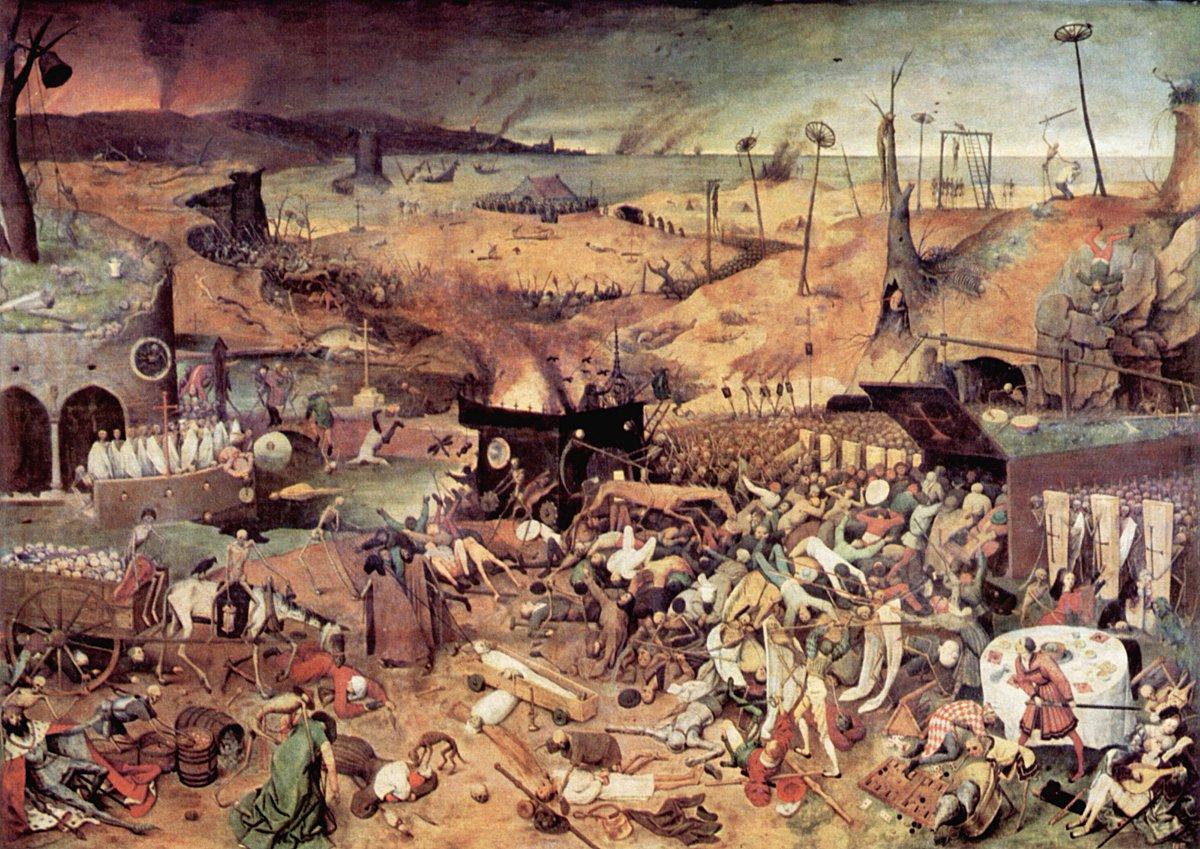 Pieter Brueghel's The Triumph of Death Towns like ‘s-Hertogenbosch would be full of gibbets, scaffolds and prisons. In this age of random and senseless violence, death was a constant and recognisable companion. His grinning image was seen in every church. And in the background of these paintings death is always present – usually in the form of a skeleton. This same leitmotif was taken over by Bosch’s only real successor Pieter Brueghel, as in his painting The Triumph of Death.
Pieter Brueghel's The Triumph of Death Towns like ‘s-Hertogenbosch would be full of gibbets, scaffolds and prisons. In this age of random and senseless violence, death was a constant and recognisable companion. His grinning image was seen in every church. And in the background of these paintings death is always present – usually in the form of a skeleton. This same leitmotif was taken over by Bosch’s only real successor Pieter Brueghel, as in his painting The Triumph of Death.
The disintegration of feudalism, which was accompanied by all sorts of convulsions – wars, famine and plague – created a large underclass of impoverished people: landless peasants, whores and beggars, peddlers and conjurers, discharged soldiers and highway robbers, who would cut a throat for a few pennies. In Germany, many of the feudal nobles became themselves robber barons who preyed on the peasants. All this social flotsam and jetsam finds its reflection in the paintings of Bosch.
The Black Death, which decimated Europe in the 14th century, wiped out at least a third of the population. It was followed by famine, which killed many others. What followed was a world of darkness, chaos and anarchy. People believed that illness was caused by demons and the Black Death was a sure sign of Divine anger. To the medieval mind, steeped in the world of religious mysticism, ghosts and superstition, it seemed that the end of the world was approaching. There was a popular belief that this would begin in the year 1500. Hell was just around the corner, and for most of humanity, there was no prospect of redemption.
The end of the world?
It was clear to all that the old world was in a state of rapid and irremediable decay. Men and women were torn by contradictory tendencies. Their beliefs were shattered and they were cut adrift in a cold, inhuman, hostile and incomprehensible world. The feeling that the end of the world is nigh is common to every historical period when a particular socio-economic system had entered into irreversible decline. Peter S. Beagle writes:
“An order of things was coming unravelled when Bosch was born. The savage security of feudalism had lain in a general understanding that - the order of things in heaven. God the Father, the Grand Seigneur, held the world in fief, parcelling the lands and powers out to his great vassals, the popes and emperors and kings, who sublet in their turn […]” (P. Beagle, The Garden of Earthly Delights, p. 14.)
Now, suddenly, all these certainties were overthrown. It was as if the lynch pin of the world had been removed. The result was terrifying turbulence and uncertainty. By the middle of the 15th century, the old system of beliefs began to unravel. People no longer looked to the Church to provide salvation, comfort and solace. Instead religious dissension arose in many different forms, and served as a guise for social and political opposition.
There are many points of similarity between the world of Bosch and the world of today, but there is also a huge gulf between them. Nowadays, at least in the West, religion is dying on its feet. But in the late Middle Ages religion was all-important. It was therefore natural that politics and the class struggle expressed itself in religious terms. Only thing that could make life a little more bearable for the mass of people: the hope of the afterlife.
The Holy Mother Church was supposed to offer comfort to the poor and the hope of a better life beyond this sinful vale of tears. But even this was being corrupted and undermined, as we see from one of Bosch’s greatest masterpieces. This was a period in which the old ideals of poverty that had inspired the early pioneers of monastic life was just a distant memory. The lords of the Church rivalled and frequently surpassed the temporal kings in their luxurious lifestyle and fantastic wealth.
This was a shocking reality that had the most serious implications for people. For if this life was so terrible, the only consolation was to cling to the hope of a better life in the next world. Once that belief was taken away, only the blackest despair remained. The authority of the church was being increasingly called into question. As a symptom of the disintegration and impending dissolution of the old order, men and women looked for salvation outside the church in all kinds of superstitious and mystical movements, in many of which unorthodox religious beliefs disguised dangerous and subversive social movements.
This was the period when large numbers of men took to the roads, barefoot and dressed in penitential rags, flogging themselves till they bled. The flagellant sects awaited the end of the world, which they anxiously expected from one hour to the next. In the end, what occurred was not the end of the world but only the end of feudalism, and what arrived was not the new Millennium but only the capitalist system. But they could not be expected to understand this.
The decline of feudal society and the rise of capitalism produced a ferment of ideas and a crisis of belief that manifested itself in the rise of oppositional currents like the Lollards and John Wycliffe in England and the Hussites in Bohemia. This is a world on the brink of a social and religious revolution. The old world is shown as rotten and corrupt to the marrow. It is tottering, waiting for its overthrow. It does not deserve to survive.
The spirit of these paintings is the same spirit that propelled the flagellants onto the road. They are impregnated with a spirit of doom. The spectacle of flagellant sects dragging their way through the towns and villages with horrid cries of “repent” interrupted by screams and groans as the lash bit into the torn flesh of bleeding backs, was a sign of the times. In his celebrated book The Waning of the Middle Ages, Johan Huizinga writes:
“A general feeling of impending calamity hangs over all. Perpetual danger prevails everywhere […] The feeling of general insecurity which was caused by the chronic forms wars were apt to take, by the constant menace of the dangerous classes, by the mistrust of justice, was further aggravated by the obsession of the coming end of the world, and by the fear of hell, of sorcerers and of devils […] Everywhere the flames of hatred arise and injustice reigns. Satan covers a gloomy earth with his sombre wings.”
The promise of salvation and eternal life exists in theory, but in reality, the general outlook of the period is the deepest shade of black. This pessimistic feeling is reflected in the poetry of the times, as in the following verses by the Frenchman Deschamps, which compares the world with a senile old man in a state of advanced decrepitude:
“Or est laches, chetis et moltz,
Vieux, convoiteux et mal parlant;
Je ne voy que foles et folz…
La fin s’approche, en verité …
Tout va mal.”
(Now the World is cowardly, decayed and weak, old, covetous, confused of speech; I see only female and male fools… Verily, the end approaches… All goes badly.)
The Haywain or The Power of Money
Under feudalism economic power was expressed as the ownership of land. Money played a secondary role. But the rise of trade and manufacture and the incipient market relations that accompanied them made Money an even greater power. But side by side with extravagant wealth, life for the masses was miserable, painful, brutish and short. The life of the peasant under feudalism was harsh in the extreme even under normal conditions. But the conditions in the late stage of feudalism were far from normal.
The rise of capitalism – especially in the Netherlands where it emerged earlier than in any other country except Italy – was accompanied by new attitudes, which gradually solidified into a new morality and new religious beliefs. The Hanseatic League, with over a hundred trading cities, controlled the commerce from England to Russia. Great fortunes were being made. Powerful banking families like the Fuggers arose and challenged the might of kings. A new power arose, a power that was disintegrating the fabric of the old society and undermining its values: the power of money.
A new spirit was abroad – the spirit of materialism and commercialism. Art itself gradually became a commodity. If the artist was successful he could himself acquire wealth and status. But the majority were merely artistic proletarians or at best artisans.
In his great triptych, The Haywain (c.1485-90; Prado, Madrid), Bosch shows a world governed by greed and violence: here the whole of humanity is running after the Haywain. A loaded hay wagon, as depicted in Bosch’s painting, would have been a familiar sight to people of the 15th century, as a symbol of food stored for the winter and thus of prosperity. But here the hay symbolises the power of wealth and money. It recalls the old Dutch proverb: "De werelt is een hooiberg; elk plukt ervan wat hij kan krijgen” (The world is a haystack and everybody grabs from it as much as he can get). All humanity is in thrall to the Haywain, which is being drawn by seven devils towards the burning fires of hell on the right hand side.
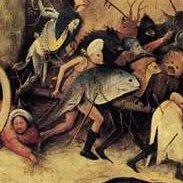 The foreground of the painting is chaotic. Everyone is fighting to obtain a bit of “hay”. In the foreground one man cuts another man’s throat for his gold. People are prepared to kill or be run over by the cart for money. Women offer their bodies for it. Magistrates sell their honour for it. To the right, the wagon is being pulled by an assortment of strange demonic creatures from the underworld. One of these creatures is a combination of a man and a fish; another is part bird, and a third is a hooded man with branches growing out of his back.
The foreground of the painting is chaotic. Everyone is fighting to obtain a bit of “hay”. In the foreground one man cuts another man’s throat for his gold. People are prepared to kill or be run over by the cart for money. Women offer their bodies for it. Magistrates sell their honour for it. To the right, the wagon is being pulled by an assortment of strange demonic creatures from the underworld. One of these creatures is a combination of a man and a fish; another is part bird, and a third is a hooded man with branches growing out of his back.
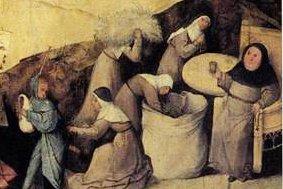 Nearby, people can be seen streaming out of a wooden doorway in a mound of earth. The Haywain itself is accompanied by men and woman trying to grab handfuls of hay; they fight and fall beneath the wheels. In the foreground of the painting we see two nuns stuffing a sack of hay for the benefit of a fat monk, who is depicted calmly drinking the sacramental wine as he supervises the plunder of his flock. The implication is not just that the Church fleeced the people, but also hints at illicit sexual relations between nuns and monks. This was a view universally held at the time – and not without good reason. There were many scandals attributed to the Church; the faithful felt themselves abandoned.
Nearby, people can be seen streaming out of a wooden doorway in a mound of earth. The Haywain itself is accompanied by men and woman trying to grab handfuls of hay; they fight and fall beneath the wheels. In the foreground of the painting we see two nuns stuffing a sack of hay for the benefit of a fat monk, who is depicted calmly drinking the sacramental wine as he supervises the plunder of his flock. The implication is not just that the Church fleeced the people, but also hints at illicit sexual relations between nuns and monks. This was a view universally held at the time – and not without good reason. There were many scandals attributed to the Church; the faithful felt themselves abandoned.
Churches were among the biggest landowners of those times. Monks and priests, although sworn to charity and poverty, paid more attention to their own material comforts than living a pious life. A large part of the wealth of the Church was raised through the sale of Indulgences – scraps of paper that promised the purchaser freedom from Purgatory for a small down payment. Hans Dietz, the notorious peddler of Indulgences, boasted that souls leaped out of hell when the coins chinked in his purse. Bosch’s attitude to the church is shown by the presence of nuns and monks eagerly participating in the chase after the Haywain.
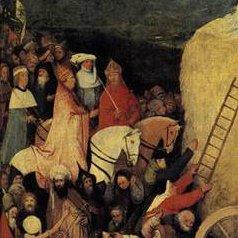 The only figures in the picture who seem cool and aloof are the rich of the earth: To the left, an emperor, a king, and a pope ride behind the cart at a respectable distance, incongruously providing an escort for a wagon-load of dried grass. However, their aloofness is deceptive. The only reason they are not also running after the cart is that they already possess more than enough “hay” – but in fact they are also its faithful and obedient slaves, and are also moving inexorably towards the Day of Judgement.
The only figures in the picture who seem cool and aloof are the rich of the earth: To the left, an emperor, a king, and a pope ride behind the cart at a respectable distance, incongruously providing an escort for a wagon-load of dried grass. However, their aloofness is deceptive. The only reason they are not also running after the cart is that they already possess more than enough “hay” – but in fact they are also its faithful and obedient slaves, and are also moving inexorably towards the Day of Judgement.
The face of evil
In Germany there late Gothic art began to reflect the new spirit of Renaissance Italy. But whereas Italian art is full of light and sunshine, the German art of these times is dark, its subject matter grim, its manner grotesque. This art is suspended between two worlds. It has a transitional character because it is the child of a traditional epoch, standing at the crossroads between late feudalism and early capitalism.
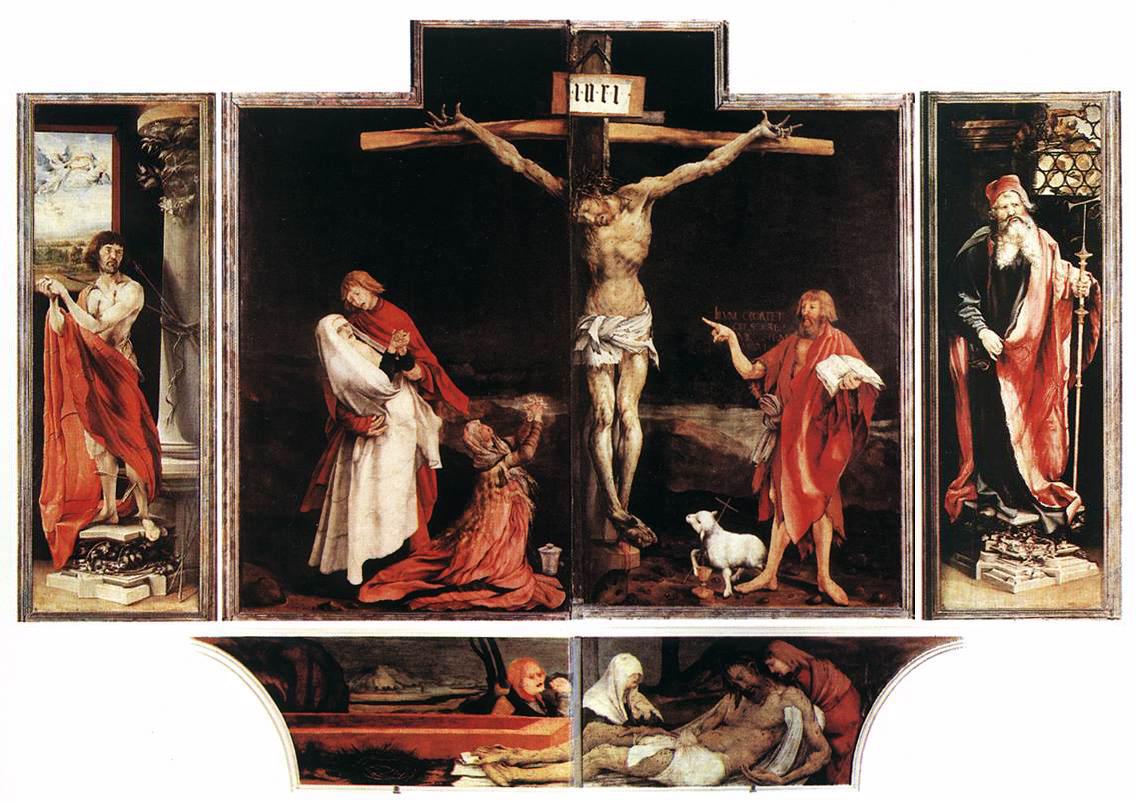 Grunewald's Isenheim The Isenheim Altarpiece is an altarpiece painted by the German artist Matthias Grünewald in 1506-1515. Here the crucifixion is depicted in a brutal and sadistic manner. Here there is no comfort, no sense of redemption and the life after death, but an unremitting blackness. The demons that are present reflect the triumph of evil. This is the art of a time of fear and anxiety. It penetrates the darkest recesses of the collective psyche in a troubled time when men and women are beset on all sides with the uncontrolled forces of evil.
Grunewald's Isenheim The Isenheim Altarpiece is an altarpiece painted by the German artist Matthias Grünewald in 1506-1515. Here the crucifixion is depicted in a brutal and sadistic manner. Here there is no comfort, no sense of redemption and the life after death, but an unremitting blackness. The demons that are present reflect the triumph of evil. This is the art of a time of fear and anxiety. It penetrates the darkest recesses of the collective psyche in a troubled time when men and women are beset on all sides with the uncontrolled forces of evil.
In his painting The Mocking of Christ, Bosch depicts men as devils, their faces contorted with inhuman expressions. Authority is reflected in the person of Pontius Pilate, who is shown as a repulsive arch-cynic and hypocrite. The only human face is that of Christ himself, soon to be martyred. Here again the vision of humanity seems to be a negative one – it is the vision of a world gone to rack and ruin, of a humanity past redemption.
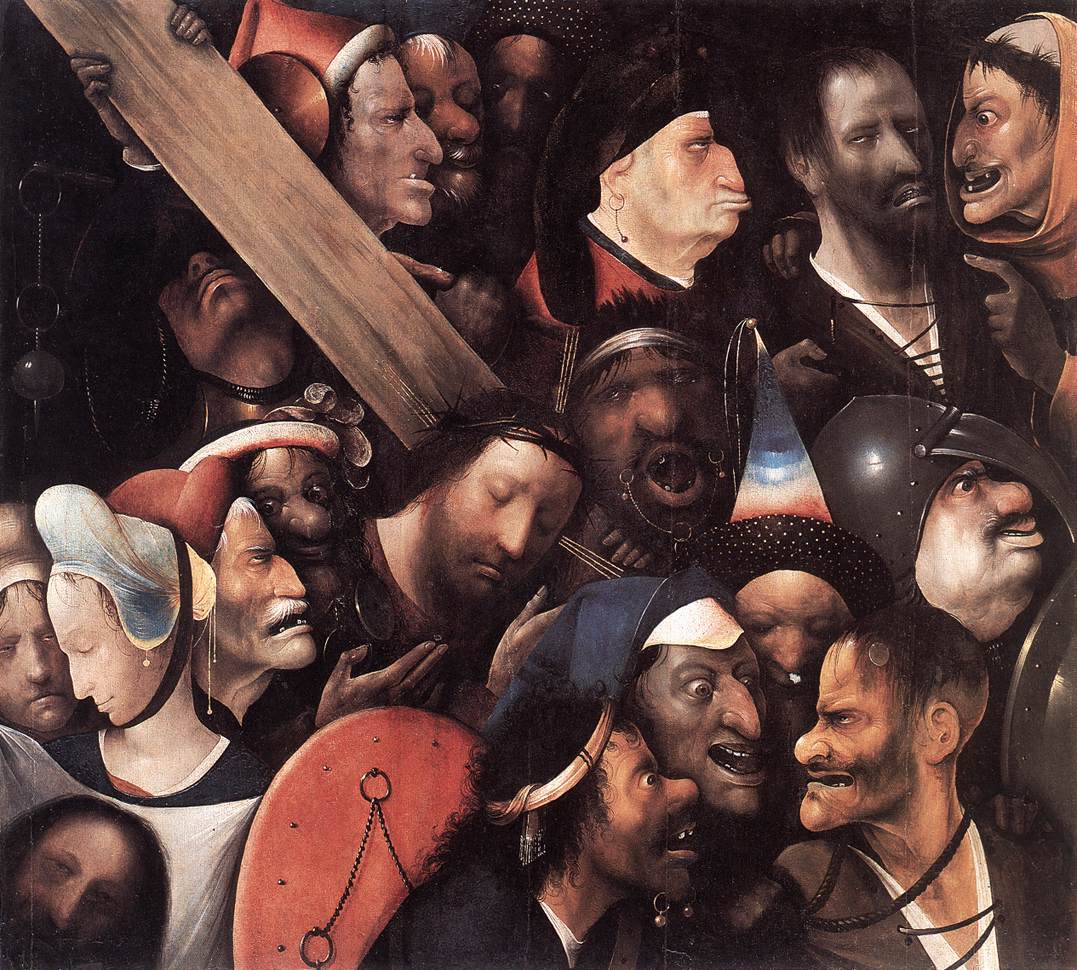 Bosch's Christ Carrying the Cross In another painting Christ Carrying the Cross that can be seen in the Museum of Fine Art in Ghent, we see the figure of a lonely and exhausted Christ surrounded by men with the faces of beasts and monsters. These are the faces of men so corrupted that they have lost all human content or feeling. However, on closer inspection, we see that such a conclusion is too sweeping. What Bosch has in his sights is not humanity in general but a specific social group. These are not the faces of poor people but rather merchants, knights and other people in authority, including a monstrous ranting Dominican monk.
Bosch's Christ Carrying the Cross In another painting Christ Carrying the Cross that can be seen in the Museum of Fine Art in Ghent, we see the figure of a lonely and exhausted Christ surrounded by men with the faces of beasts and monsters. These are the faces of men so corrupted that they have lost all human content or feeling. However, on closer inspection, we see that such a conclusion is too sweeping. What Bosch has in his sights is not humanity in general but a specific social group. These are not the faces of poor people but rather merchants, knights and other people in authority, including a monstrous ranting Dominican monk.
Whereas the sinners suffering the torments of hell are depicted in the paintings of Bosch with a certain detached compassion, to these men he shows open hatred. Here too is a lesson from our own times. Bosch was painting at a time when market values and money were new phenomena that had only recently emerged as a social force. Nowadays we speak of a man being “worth” a billion dollars and do not even think about what we are saying – that people have become mere commodities, things for sale.
In defence of their power, wealth and privileges, the rich and powerful are capable of showing terrifying ferocity and cruelty. The dehumanised faces in Christ Carrying the Cross are the faces of greed and voracious uncontrolled appetite and the corruption of the human spirit. They are the faces of the wealthy and powerful of the earth – not as they would like to present themselves but as they are. Bosch mercilessly strips away the smiling mask to reveal the vicious animal that lurks behind it.
Of course, those in positions of power like to see themselves in a different light, as the benefactors of humanity, the “givers of work”, the “captains of industry” and the like. Fawning portrait painters present them in the most favourable light. The Hay wagon is the key to all this. It is a product of the so-called market economics that corrupt the world and rob it of its humanity.
The Garden of Earthly Delights
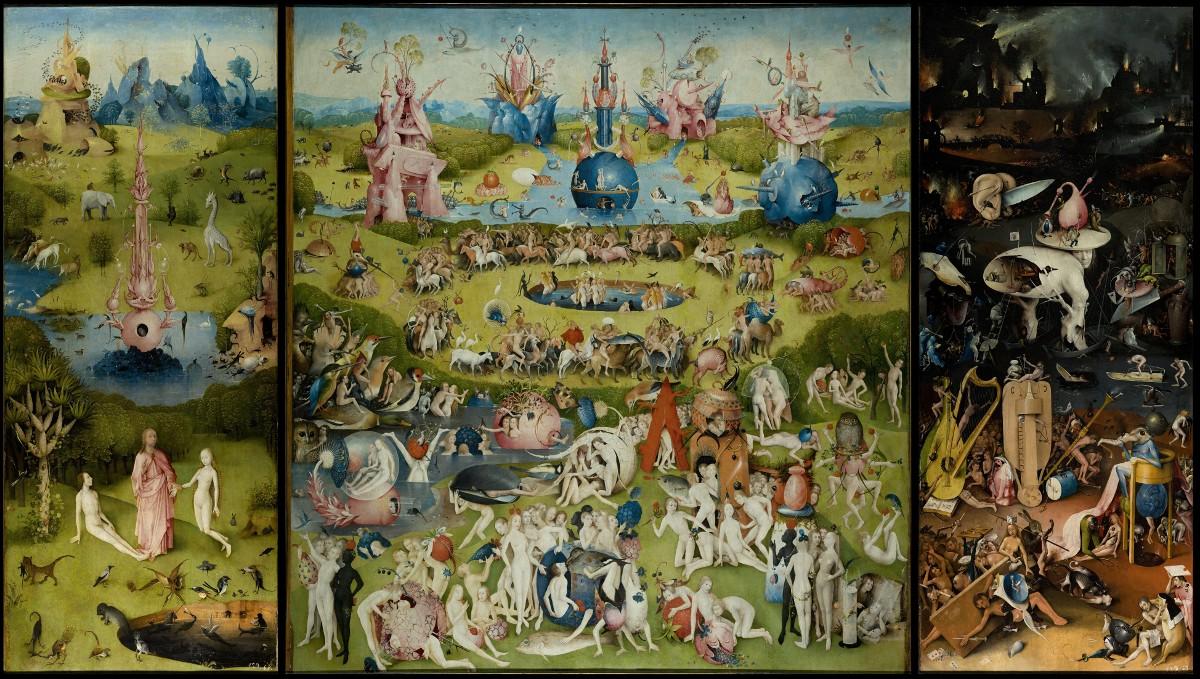
The Prado museum in Madrid is home to Bosch’s greatest masterpiece, The Garden of Earthly Delights. Here the tragedy of human existence is expressed in a spectacular tour de force. The whole thing is a mad riot of colour and movement that almost sets the head spinning. There is such a mass of detail, such startling images and juxtapositions that it is impossible to take in all at once. But when we concentrate on each detail, we marvel at the richness of its conception.
In The Garden of Earthly Delights, we are confronted with a recurrent theme of Bosch – temptation. This is itself a contradiction and a manifestation of the conflict of antagonistic tendencies. The forbidden fruit (earthly sensual enjoyment, or the sins of the flesh) is presented as fruit and as beautiful naked women – the most desirable of all forbidden fruits. The same imagery can be seen in The Temptations of Saint Anthony. On closer inspection, what Bosch is painting is not the delights of earth but the torments of hell.
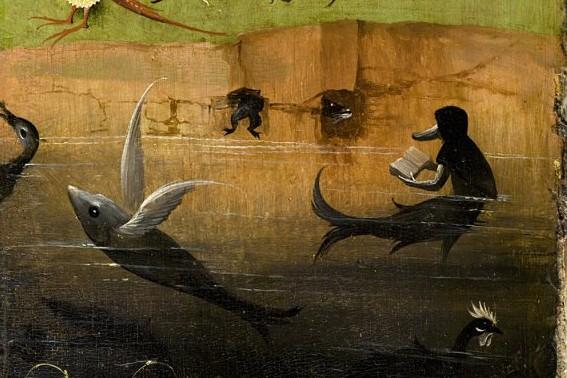 The painting is a triptych (as is The Haywain), that is to say, it is divided into three parts. In typical medieval style, it is an allegory. It tells a story. More correctly, it tells the story of man’s Fall from Grace. From left to right, it begins with the Garden of Eden. But even in this paradise, the seeds of evil are already present. Here already we see monsters: a fish with human hands and a duck's head clutches a book while emerging from a cavity, while a lion has killed his prey and is about to devour it. The grotesquely shaped fountain of Life in the centre of the picture is topped by a crescent moon, the mark of the Devil, with associations with Islam and the Turk.
The painting is a triptych (as is The Haywain), that is to say, it is divided into three parts. In typical medieval style, it is an allegory. It tells a story. More correctly, it tells the story of man’s Fall from Grace. From left to right, it begins with the Garden of Eden. But even in this paradise, the seeds of evil are already present. Here already we see monsters: a fish with human hands and a duck's head clutches a book while emerging from a cavity, while a lion has killed his prey and is about to devour it. The grotesquely shaped fountain of Life in the centre of the picture is topped by a crescent moon, the mark of the Devil, with associations with Islam and the Turk.
 Even more sinister is the owl that stares out of a hole in the bottom of the fountain. Whereas for the ancient Athenians this was a bird associated with Athena the goddess of wisdom (hence the “wise owl”), in the Middle Ages this night bird with its sinister shriek was associated with evil. The owl constantly reappears in many of Bosch’s works.
Even more sinister is the owl that stares out of a hole in the bottom of the fountain. Whereas for the ancient Athenians this was a bird associated with Athena the goddess of wisdom (hence the “wise owl”), in the Middle Ages this night bird with its sinister shriek was associated with evil. The owl constantly reappears in many of Bosch’s works.
The central panel presents a vast panorama of life: nude figures, fantastical animals, oversized and overripe fruit and hybrid stone formations. The giant strawberries that men desperately strive to taste are a symbol of temptation in its most obvious form – sex.  The huge fish that appear on all sides are a phallic symbol. In the first panel, humans (Adam and Eve) are bigger than the animals and on a similar scale to Jesus (God). But here the dimensions are transformed.
The huge fish that appear on all sides are a phallic symbol. In the first panel, humans (Adam and Eve) are bigger than the animals and on a similar scale to Jesus (God). But here the dimensions are transformed.
 The central panel contains many birds that mingle with the humans and even provide them with (forbidden) fruit. Here we have a stroke of genius that brings us close to surrealism. In everyday life birds are generally seen as harmless. They attract us with their colourful feathers and tuneful songs. But these birds are a sinister and menacing presence. They are blown up in size and are far bigger than the humans. With their vacantly staring eyes and powerful sharp beaks, they seem to threaten the naked and defenceless humans around them.
The central panel contains many birds that mingle with the humans and even provide them with (forbidden) fruit. Here we have a stroke of genius that brings us close to surrealism. In everyday life birds are generally seen as harmless. They attract us with their colourful feathers and tuneful songs. But these birds are a sinister and menacing presence. They are blown up in size and are far bigger than the humans. With their vacantly staring eyes and powerful sharp beaks, they seem to threaten the naked and defenceless humans around them.
In The Garden of earthly Delights there is danger at every step. Bosch is warning us of the transience of all worldly pleasures. The sweet taste of the luscious fruit soon disappears. All humankind is heading for just one direction and that is shown on the right panel. Here we have a truly hellish landscape depicting in graphic detail the torments of the damned.
 The condemned figures are punished according to their sins: the gluttons are condemned to eternal vomiting or are excreted by the Devil who has a bird’s head. A man (possibly a musician in life) has his body penetrated by the strings of a harp, while another with a flute inserted in his anus. There is an astonishing variety of demons and monsters of every description, every one the stuff of nightmare.
The condemned figures are punished according to their sins: the gluttons are condemned to eternal vomiting or are excreted by the Devil who has a bird’s head. A man (possibly a musician in life) has his body penetrated by the strings of a harp, while another with a flute inserted in his anus. There is an astonishing variety of demons and monsters of every description, every one the stuff of nightmare.
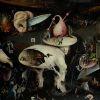 However, the most terrifying and perplexing of all the monsters in Hell is the Tree Man who is situated in the centre of the painting. His hollow torso, standing on a pair of rotting tree trunks, is pierced by sharp branches that protrude from his own body. The tree-man gazes outwards beyond the viewer, his strange, wistful expression suggest that the tree-man may be a self-portrait of Bosch himself, mournfully surveying the spectacle of humanity’s downfall.
However, the most terrifying and perplexing of all the monsters in Hell is the Tree Man who is situated in the centre of the painting. His hollow torso, standing on a pair of rotting tree trunks, is pierced by sharp branches that protrude from his own body. The tree-man gazes outwards beyond the viewer, his strange, wistful expression suggest that the tree-man may be a self-portrait of Bosch himself, mournfully surveying the spectacle of humanity’s downfall.
Contradictions
These remarkable paintings show extreme contrast between light and darkness, but in the end darkness always wins. Here are all the nightmares of the Middle Ages rolled into one. Here is hell-fire and brimstone. Here is eternal damnation and darkness, the wailing and the gnashing of teeth.
In the paintings of Bosch we are gripped by a powerful sense of contradiction. We do not only see this agonising conflict of incompatible tendencies: we feel it, touch it, hear it and smell it. The imagery is so vivid that it springs out of the painting and seizes you by the throat. Frequently it evokes the art of surrealism – which was the product of a similar historical context. There are the same underlying contradictions, which are presented in a stark juxtaposition.
Bosch painted the period in which he lived and reflected it as a mirror. This is hell upon earth. But for the great majority of men and women, the fifteenth century was already a kind of hell on earth. There is great profundity here. Like all great art, this does not stay on the surface but penetrates the deepest parts of the human psyche, bringing all its most secret dreams and nightmares to the surface. Here art imitates life.
In a world where many went hungry, we see scenes of appalling gluttony. Here is the same gross inequalities of riches and poverty, of inequality and injustice that exist in our own times. Unable to correct these crying injustices in fact, Bosch punishes them in painting. The sufferings of the damned closely correspond to the nature of their sins: proud and lecherous women are made love to by frogs and lizards that cling to their private parts. This is an expression of the essential misogyny of the Christian world-view according to which Original Sin was the invention of the universal mother Eve. Musicians are tormented by their own instruments that become transformed into implements of torture, etc.
The artistic inspiration for these visions has its roots in the medieval past, although it seems strikingly modern. It is to be found in the grotesque figures of demons and sinners on the walls outside churches – gargoyles etc. This was really the liveliest part of this old art. But hitherto it assumed a subordinate role, whilst here it comes to the fore and takes on a life of its own.
Reformation and counter-reformation
Death finally caught up with Bosch in his native ’s-Hertogenbosch in 1516. One year later a young monk called Martin Luther strode up to the church in Wittenberg and nailed his 95 theses to the door. The revolt of the bourgeoisie against feudalism found its first expression, inevitably, in religious protest. The Protestant religion at bottom expressed the outlook and interests of the bourgeoisie. The old feudal order found its most fanatical standard-bearer in Catholic Spain.
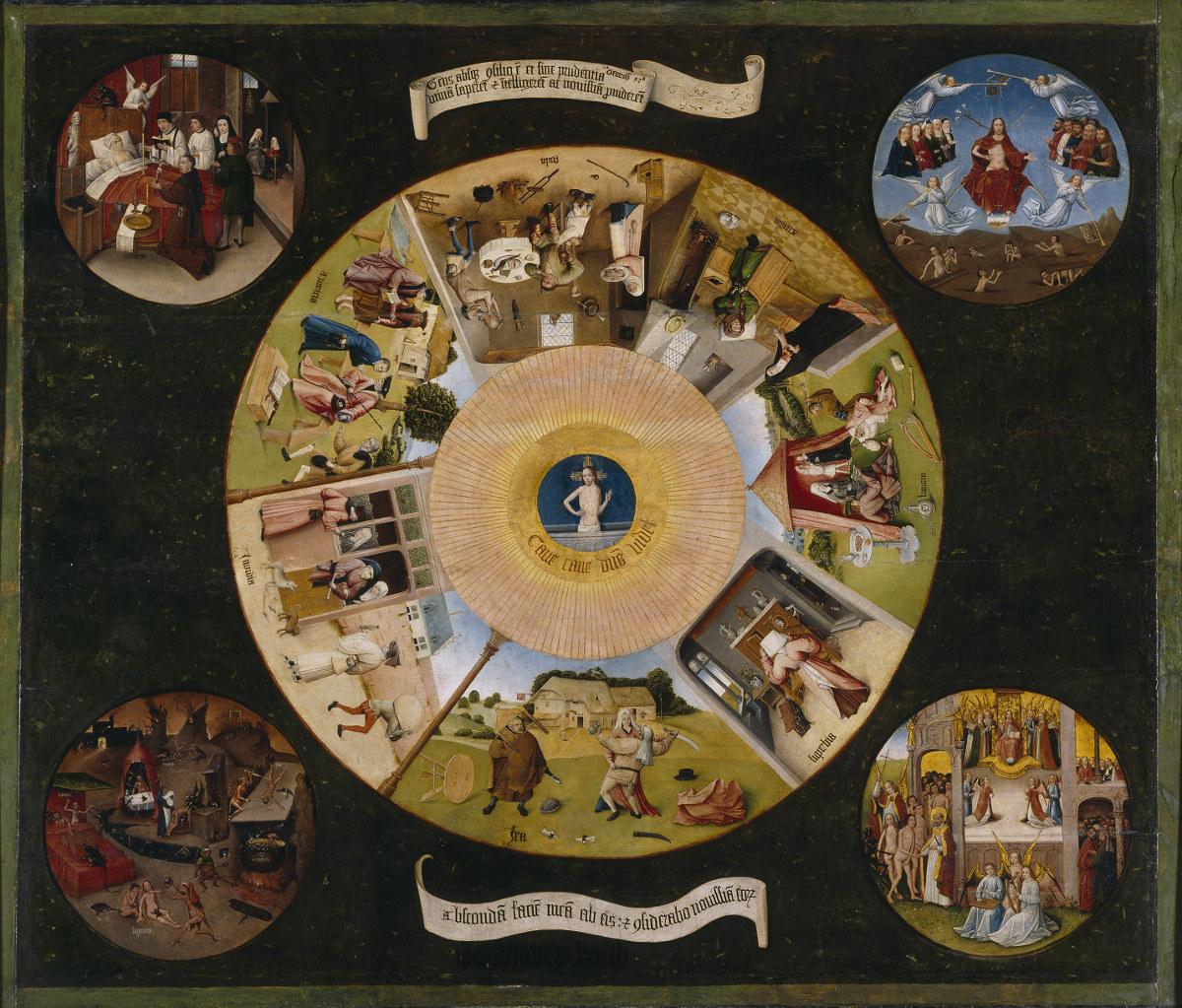 The Seven Deadly Sins and the Four Last Things All Europe now stood on the brink of a period of revolution and counter-revolution in the disguise of wars of religion. It was about to enter into a Dance of Death that was to last for three decades. The fires that blaze in Bosch’s tormented vision of hell raged in the cities of Holland, Germany and Bohemia. Nowhere were the wars of religion fought out with greater cruelty than in the homeland of Hieronymus Bosch, where the first bourgeois revolution in history was manifested as a war of national independence of the Netherlands against Spain.
The Seven Deadly Sins and the Four Last Things All Europe now stood on the brink of a period of revolution and counter-revolution in the disguise of wars of religion. It was about to enter into a Dance of Death that was to last for three decades. The fires that blaze in Bosch’s tormented vision of hell raged in the cities of Holland, Germany and Bohemia. Nowhere were the wars of religion fought out with greater cruelty than in the homeland of Hieronymus Bosch, where the first bourgeois revolution in history was manifested as a war of national independence of the Netherlands against Spain.
The fiendish torments depicted by Bosch resemble those actually inflicted by the Spanish Inquisition on the bodies of helpless men and women in the name of religion. After the sinister Duke of Alba had crushed the first revolt of the Protestant Netherlands in blood, many of Bosch’s most famous paintings were taken to Spain. Phillip the Second, the fanatical Catholic and leader of the anti-Protestant crusade, was an enthusiastic admirer of Bosch and either bought or confiscated all of his works he could get his hands on. He kept them in his Escorial palace, that strange mixture of monastery and imperial power centre.
A table that Bosch had painted with the motif of the Seven Deadly Sins he had placed in his bedroom and it was still there when he died. It bears the cryptic warning: “Beware, God sees.” But it is doubtful if Philip saw anything. He did not understood either Bosch or his paintings, which contain a ferocious denunciation of the Roman Church and its corrupt practices, like the unforgettable picture of a sow with a nun’s headdress on, pressing a man to sign a document – probably to sign his worldly goods away to the Church. These paintings contain a stark portrayal of the moral decay and internal rottenness of the Church.
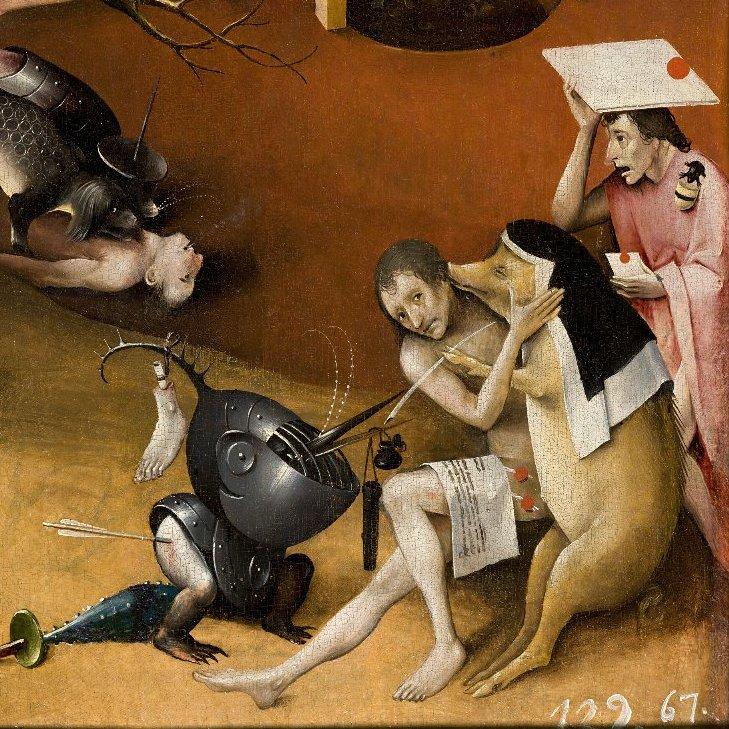 Detail from The Garden of Earthly Delights By a strange quirk of history, Bosch’s work was enthusiastically endorsed by the leaders of the Counter-reformation, like Fray José de Sigüenza the spiritual councillor of King Philip. In fact there is not a single painting of a monk or a nun in all of Bosch’s paintings where they are presented in a favourable light. If Bosch was preparing the way for something it was the overthrow of the Church, not its defence. One might even say that Luther gave a coherent expression to the incoherent ideas that Bosch expressed in art. In that sense art foreshadows history.
Detail from The Garden of Earthly Delights By a strange quirk of history, Bosch’s work was enthusiastically endorsed by the leaders of the Counter-reformation, like Fray José de Sigüenza the spiritual councillor of King Philip. In fact there is not a single painting of a monk or a nun in all of Bosch’s paintings where they are presented in a favourable light. If Bosch was preparing the way for something it was the overthrow of the Church, not its defence. One might even say that Luther gave a coherent expression to the incoherent ideas that Bosch expressed in art. In that sense art foreshadows history.
Some experts have even suggested that Bosch was a member of one of the numerous dissident and heretical sects that arose at that time like mushrooms after a thunderstorm. Wilhelm Fraenger tried to prove that he was a member of a dissident religious sect – the Adamites. They called themselves brother and sister, and women held a prominent position among them. They celebrated the tree and the delights of paradise. They worshipped together in the nude, like Adam and Eve before the Fall. This was a revolutionary idea, pregnant with egalitarianism. Fraenger claims that Bosch’s paintings are based on Adamite rituals. However, other writers have disputed this, and there is no real proof for it.
Then and now
Bosch can be seen as the last painter of the Middle Ages. Referring to the art of that period, Walter Bosin has written: “The dying Middle Ages flared up with great brilliance before dying forever.” (Hieronymus Bosch, c. 1450-1516: between heaven and hell) But this art does not seem medieval to us. It speaks to us loud and clear. It is jot just that his style and technique are startlingly modern. It has to do with its inner message. This is art that has something to say. It fearlessly looks reality in the face and asks us to pronounce judgement upon it. What a contrast to the sterile irrelevances of the art of today!
Bosch painted at a time when capitalism was in its early beginnings. Its heroic age was still in the future. This fell outside the field of vision of Bosch. All he could see were the clear symptoms of a society in the phase of terminal decline. Whenever a given socio-economic system has exhausted its potential, we see the same symptoms: economic crises, wars and internal conflicts, moral decay and a crisis of ideas, reflected in a falling off of faith in the old religion and morality, accompanied by a rise in mystical and irrational tendencies, a general sense of pessimism and lack of confidence in the future, the decay of art and culture.
These are the features one would expect to find in a society that has exhausted its progressive role and is unable to develop the productive forces as it did in the past. In every case, there is a feeling that “the end of the world is approaching”. In ancient Rome this belief found its reflection in the Christian religion that taught that the world was about to end in flames from one day to the next. In the period of the decline of feudalism, the flagellant sects marched through the towns and villages predicting the end of the world. In both case, what was approaching was not the end of the world but the demise of a definite socio-economic system (slavery, feudalism).
Now, as the first decade of the 21st century comes to an end, it is clear that capitalism itself has entered into a phase of terminal decline.
The world of Hieronymus Bosch had many things in common with our own. The world of the early 21st century is a world of turbulence, violence and chaos. It is the world of 11th September and the rape of Iraq and Afghanistan. We live in a world where humanity is wracked by wars, starvation and misery alongside the most obscene wealth and ostentation.
The sickness of the system is manifested at all levels. Five centuries later, the Haywain still trundles on, crushing men and women beneath its heavy wheels. Capitalist alienation and the fetishism of commodities has become such a part of our psyche that we are not even aware of it. It would take an artist of the stature of Bosch to bring these deeply hidden prejudices to the surface of our consciousness.
Never in history has the rule of Money been so entrenched as in our own period. People are degraded to the level of objects and inanimate things acquire the characteristics of people. In the process humanity is debased, impoverished and annihilated. Those callous, inhuman faces contorted with avarice and greed that appear in Bosch’s paintings can be found today on the trading floors of the stock exchange, those vast casinos where the lives of millions are decided through the convulsive movements of the markets.
The nightmarish vision of Bosch is not so far removed from the condition of our own age, except that instead of paintings, we can see the very same frightening images every night on the screens of our television sets. Yet this finds no real expression in contemporary art. Four million men, women and children are slaughtered in civil wars in the Congo, and the best our British artists can produce is an unmade bed.
Why is it that people are always looking backwards, wistfully admiring the great art of the past? It is because art no longer has anything meaningful to say. Pablo Picasso produced his masterpiece Guernica in response to the Spanish Civil War. Goya produced his Disasters of War as a commentary and a judgement on the horrors of his own times. But today even sharks must be presented to us dead and pickled in formaldehyde.
It is art itself that has been sterilised and embalmed in a glass case. For the first time in centuries, art has nothing to tell us about the world in which we live. It has become the property of a tiny clique of profiteers and aesthetes remote from reality and life. If art displays indifference to the real lives and concerns of people, it is no wonder that people display complete indifference to art.
Our age needs its own Hieronymus Bosch to hold a mirror up to its face and show it as it really is. Somewhere out there such artists must exist, but their voices are not heard. They are drowned out by the noisy carnival of money-making that dominates art just as it dominates the rest of society. Sooner or later the real voice of art, a truthful and courageous voice, will make itself heard, and humanity will be all the richer for it.
London 23rd December 2010

